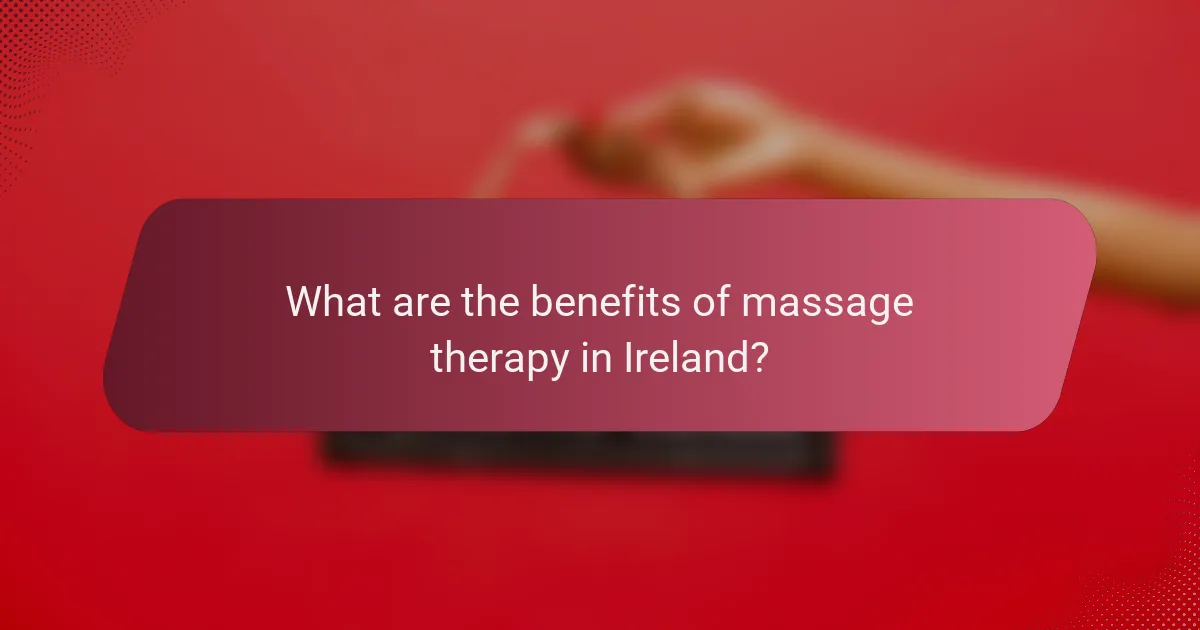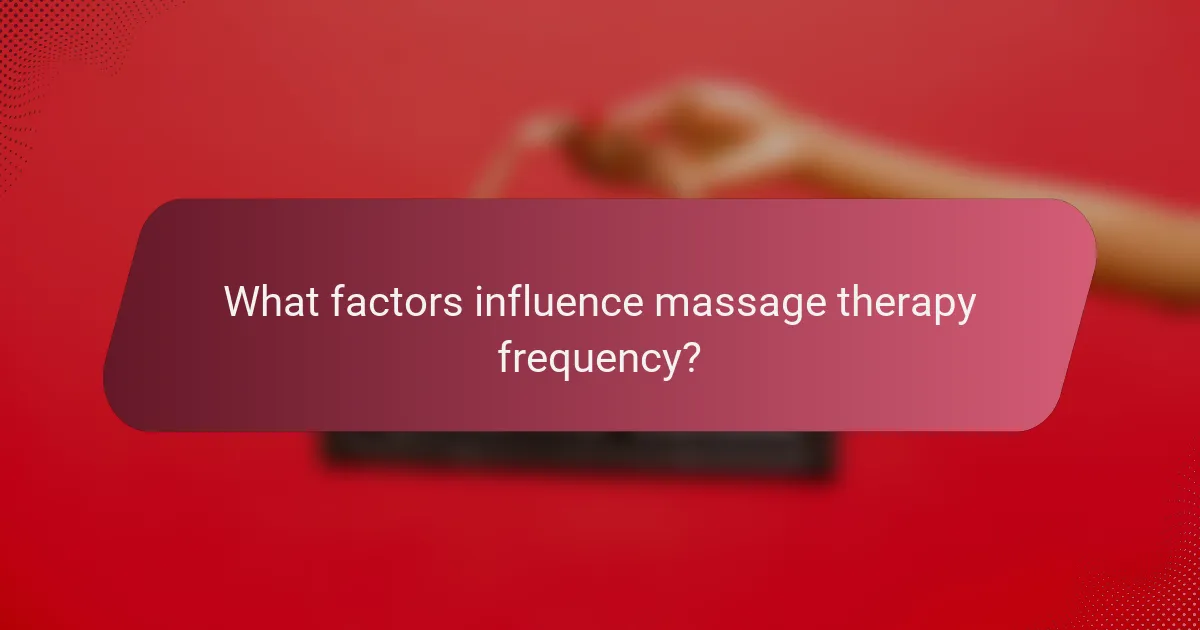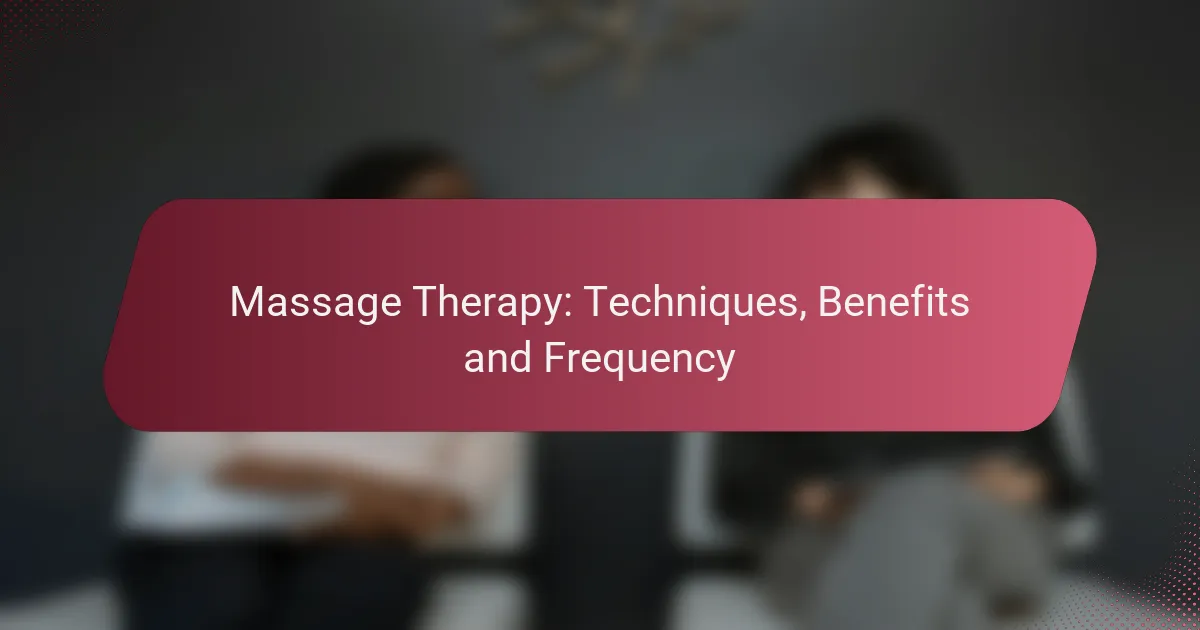Massage therapy is a holistic approach that provides a range of benefits, including stress relief, pain management, and improved circulation. With various techniques available, such as Swedish and deep tissue massages, individuals can find tailored solutions to enhance their well-being. The frequency of sessions can vary, typically ranging from weekly to monthly, depending on personal needs and health goals.

What are the benefits of massage therapy in Ireland?
Massage therapy offers numerous benefits in Ireland, including stress relief, pain management, improved circulation, enhanced flexibility, and better sleep quality. These advantages contribute to overall well-being and can be tailored to individual needs.
Stress reduction
Massage therapy is highly effective for stress reduction, as it promotes relaxation and lowers cortisol levels. Techniques such as Swedish massage or deep tissue work can help release tension in the muscles, leading to a calmer state of mind.
In Ireland, many people find that regular massage sessions can significantly decrease anxiety and improve their mood. Consider scheduling a massage at least once a month to maintain these benefits.
Pain relief
Massage therapy can provide substantial pain relief, particularly for chronic conditions like back pain, arthritis, or headaches. By manipulating soft tissues, therapists can alleviate discomfort and improve mobility.
In Ireland, individuals suffering from sports injuries or muscle strains often turn to massage as a complementary treatment. Combining massage with other therapies can enhance overall pain management strategies.
Improved circulation
Massage therapy enhances circulation by stimulating blood flow and lymphatic drainage. This increased circulation helps deliver oxygen and nutrients to tissues while removing waste products.
Incorporating techniques such as effleurage and petrissage can be particularly beneficial for those with sedentary lifestyles. Regular sessions can lead to improved cardiovascular health and faster recovery from physical exertion.
Enhanced flexibility
Massage therapy can improve flexibility by loosening tight muscles and increasing the range of motion in joints. Techniques like stretching and myofascial release are often employed to achieve these results.
For athletes in Ireland, enhanced flexibility can lead to better performance and reduced risk of injury. Consider integrating massage into your training regimen to maintain optimal physical condition.
Better sleep quality
Massage therapy can promote better sleep quality by reducing stress and encouraging relaxation. The calming effects of massage can help individuals fall asleep faster and enjoy deeper sleep cycles.
In Ireland, many people report improved sleep patterns after regular massage sessions. To maximize these benefits, aim for a massage in the evening or before bedtime to help unwind and prepare for restful sleep.

What are the most popular massage techniques?
The most popular massage techniques include Swedish, deep tissue, sports, hot stone, and aromatherapy massages. Each technique offers unique benefits and approaches to relaxation and pain relief, catering to different needs and preferences.
Swedish massage
Swedish massage is characterized by long, flowing strokes, kneading, and circular movements on the topmost layer of muscles. This technique promotes relaxation, improves circulation, and can help alleviate tension. It’s often recommended for those new to massage therapy or seeking a gentle, soothing experience.
Typically, a session lasts between 60 to 90 minutes, and clients can expect to feel a sense of calm and reduced stress afterward. To enhance the experience, therapists may use essential oils or lotions that complement the massage.
Deep tissue massage
Deep tissue massage focuses on the deeper layers of muscle and connective tissue, using slower strokes and more intense pressure. This technique is beneficial for chronic pain, muscle tension, and injury recovery. It’s particularly effective for athletes or individuals with specific areas of discomfort.
Sessions usually range from 60 to 120 minutes, and while it may cause some discomfort during treatment, many find the relief afterward worth it. It’s important to communicate with the therapist about pressure levels to ensure a comfortable experience.
Sports massage
Sports massage is tailored for athletes and active individuals, focusing on areas of the body that are overused and stressed from repetitive movements. This technique can be used before, during, or after sports events to enhance performance and aid recovery.
Typically lasting 30 to 90 minutes, sports massage may incorporate techniques from both Swedish and deep tissue massages. Athletes should consider scheduling sessions regularly to maintain flexibility and prevent injuries.
Hot stone massage
Hot stone massage involves the use of heated stones placed on specific points of the body to promote relaxation and ease muscle tension. The warmth from the stones enhances the effects of the massage, allowing deeper penetration into the muscles.
Sessions generally last between 60 to 90 minutes, and clients often report feeling deeply relaxed and rejuvenated. It’s essential to ensure that the therapist uses stones at a safe temperature to avoid burns.
Aromatherapy massage
Aromatherapy massage combines the benefits of massage with the therapeutic properties of essential oils. The oils are chosen based on their individual properties, such as relaxation, stress relief, or invigoration, and are incorporated into the massage technique.
Sessions can last anywhere from 60 to 90 minutes, and the choice of essential oils can greatly enhance the overall experience. Clients should discuss any allergies or sensitivities with their therapist to ensure a safe and enjoyable session.

How often should you get a massage in Ireland?
In Ireland, the frequency of massage therapy sessions can vary based on individual needs and goals. Generally, many people benefit from regular sessions, which can range from weekly to monthly, depending on their lifestyle, stress levels, and specific health concerns.
Weekly sessions
Weekly massage sessions are ideal for those experiencing high levels of stress, chronic pain, or recovering from injuries. This frequency allows for consistent relief and can help maintain muscle flexibility and overall well-being.
For individuals with demanding jobs or active lifestyles, weekly massages can serve as a proactive approach to prevent tension buildup. It’s advisable to communicate with your therapist to tailor the sessions to your specific needs.
Bi-weekly sessions
Bi-weekly sessions are a good compromise for those who want to enjoy the benefits of massage without committing to weekly appointments. This schedule can help manage stress and muscle tension effectively while being more budget-friendly.
Consider bi-weekly massages if you lead a moderately active lifestyle or are managing mild to moderate discomfort. This frequency often allows for adequate recovery time between sessions while still providing therapeutic benefits.
Monthly maintenance
Monthly maintenance massages are suitable for individuals who are generally healthy and wish to maintain their well-being. This frequency can help reduce stress and promote relaxation without overwhelming your schedule or finances.
For those who may not experience significant tension or pain, a monthly session can serve as a preventive measure. It’s important to listen to your body and adjust the frequency if you notice increased stress or discomfort.

What factors influence massage therapy frequency?
The frequency of massage therapy sessions is influenced by various factors, including personal health goals, physical activity levels, and stress levels. Understanding these elements can help individuals determine how often they should seek massage therapy for optimal benefits.
Personal health goals
Your personal health goals play a significant role in determining how often you should receive massage therapy. For instance, if your aim is to manage chronic pain or recover from an injury, more frequent sessions—possibly once or twice a week—may be beneficial. Conversely, if you are seeking relaxation or general wellness, monthly sessions might suffice.
Consider discussing your specific goals with a licensed massage therapist who can tailor a plan that aligns with your needs. Regular assessments can help adjust the frequency as your goals evolve.
Physical activity level
Individuals with higher physical activity levels, such as athletes or those engaged in rigorous exercise routines, may require more frequent massage therapy. Weekly sessions can aid in muscle recovery, reduce soreness, and enhance performance. On the other hand, those with a sedentary lifestyle may find that bi-weekly or monthly massages are adequate to maintain muscle health and relaxation.
It’s essential to listen to your body; if you notice increased tension or discomfort, it may be time to increase the frequency of your sessions.
Stress levels
High stress levels can significantly impact your well-being, making regular massage therapy a valuable tool for stress management. If you are experiencing chronic stress, weekly sessions can provide relief and help you develop coping strategies. For those with moderate stress, bi-weekly or monthly massages may be effective.
Monitoring your stress levels and adjusting your massage frequency accordingly can enhance the therapeutic benefits. Incorporating self-care practices alongside massage can further support your overall mental health.

How to choose a massage therapist in Ireland?
Choosing a massage therapist in Ireland involves verifying their qualifications, reading client reviews, and considering their specialties. This ensures you find a qualified professional who meets your specific needs.
Check qualifications
Start by confirming that the massage therapist is properly qualified and certified. In Ireland, reputable therapists often hold qualifications from recognized institutions and are members of professional bodies such as the Irish Massage Therapists Association (IMTA).
Look for certifications in specific techniques, such as Swedish massage, deep tissue, or sports massage. This can indicate their level of expertise and ability to address your particular concerns.
Read reviews
Client reviews can provide valuable insights into a therapist’s skills and approach. Check online platforms, social media, or local directories for feedback from previous clients.
Pay attention to comments about the therapist’s professionalism, the effectiveness of their techniques, and the overall atmosphere of their practice. This can help you gauge whether they might be a good fit for you.
Consider specialties
Different massage therapists may have various specialties, such as prenatal massage, sports therapy, or therapeutic massage for chronic pain. Identify what type of massage you need and seek therapists who focus on those areas.
For instance, if you are an athlete, you might prefer a therapist who specializes in sports massage to help with recovery and performance. This targeted approach can enhance the benefits you receive from your sessions.
